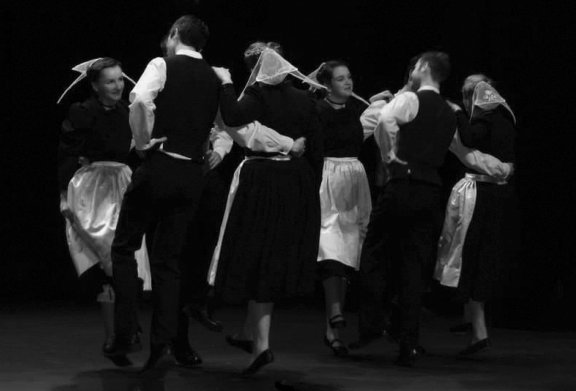29.09.23 — 14:00
CN D à Pantin
14:00 – 35 min.
“Breton dance” championships and competitions: from preserving a practice to constructing a cultural object
by Marc Clérivet et Tristan Jézéquel Coajou
Competitions between musicians and dancers were a frequent thing in 19th-century Brittany and they endured in revivalist practices. Celtic circles have preserved and kept these practices alive until today by organizing individual and group competitions. In order to establish objective evaluating criteria, these federations have drawn up descriptive “technical bullet point sheets” from individual specificities they had collected and which they considered to be representative. These documents have created a repertory and they have shaped how traditional Breton dances are taught and danced, therefore limiting the individual variability of these collective practices. These new contexts have induced the creation of models that have been imprinted on dancing bodies and have restricted the creativity of artists identifying with that particular style, as well as the evolution of practices and repertories.
14:35 – 2h
Panel : National agenda and the fashioning of dancing bodies in and through competition
Fashioning social dance through competition: nation and capital in the early English style of ballroom
by Theresa Jill Buckland
In early 20th-century Britain, an exclusive corps of metropolitan-based social dancers instituted competitions that deliberately set out to foster a low-key, simple and elegant style that they believed better reflected the perceived national character. The physical challenge for competing dancers to be exceptional lay not in the typical sports-like demonstrable performance of physical skill, remarkable endurance or the achievement of seemingly super-human corporeal feats, but in a well-mannered quiet execution of dancing that evaded notice. The result was the emergence of a distinctive mode of couple dancing known as the English style which became the core aesthetic of modern ballroom dancing. This paper will consider early competitive ballroom dancing in relation to contemporaneous structural models of competition, the ‘art worlds’ of Becker (1982), and critiques of institutional theory (DiMaggio, 1982).
Shifting value systems in Irish Step-Dancing: From informal rivalry to formal staged competitions
by Catherine Foley
Focusing on informal rivalry in the 19th century to formal staged competitions in the 20th century, this paper looks at shifting value systems in step dancing in Ireland. It first examines how itinerant dancing masters codified step dancing into a specific cultural movement system and often challenged each other assisting in choreographic develop-ment. In the 20th century, step dancing as Irish dancing was “invented” by the cultural nationalist movement, the Gaelic League, and became a site for performing politics. In the context of nation building, a different kind of rivalry associated with formal staged competitions emerged. These competitions provided a site where Foucault’s double-edged system of gratification/punishment was displayed while also assisting in developing a choreographic culture. Based on ethnographic research, insight is provided into how competition in Irish dancing developed and how social and political circumstances shaped such developments into the 21st century.
Folk dance remixed: identity politics in the world of garba competitions
by Ann R. David
The swish of long, colorful skirts, the high, impactful moves and loud beat of live music signals annual competitive garba raas dance events now found all over the world. I examine these Indian folkdance competitions in the US and UK, now reconfigured in new forms by 2nd and 3rd generation Gujaratis. Events take place in community halls, university campuses, hired theatres and express a kind of ‘garba fever’. In the UK where such dance competitions have a forty-year history the different iterations include community based, folkloric nationalistic and diasporic groups. What might be the purpose of these popular competitive events? Does the current move to include Gujarati garba into UNESCO’s list of Intangible Cultural Heritage affect practice? The paper investigates political influences, identities, and sporting links in the growth of garba competitions, examining their geopolitical and geo-aesthetic contexts, whether local, transregional, national or global.
DanceSport and the Olympic Games
by Gediminas Karoblis
In 1815, the “dancing” Congress of Vienna drew the political contours of Europe for a century. Tsar Alexander of Russia legitimized the Viennese waltz as the dance of emperors and empresses. At the end of this period, the Olympic Games were revived. The waltz and the transatlantic dance traditions intertwined, giving rise to the organized competitive ballroom dance. The first world championships were held in Paris. I will present in what way competitive ball-room – DanceSport (after 1990) reflects modernity of the twentieth and twenty-first centuries, how it changed in over one hundred years, including the Soviet Union, and finally, what are deep and ultimate reasons that motivated the World DanceSport Federation (WDSF) to lobby the International Olympic Committee for inclusion of a dance sport in the program of the Olympic Games. Eventually, under umbrella of WDSF breakdancing has been included in the Paris 2024 Summer Olympic Games.
Neutralising conflict and democratising bodies through festival dance competition: a Nigerian example
by Georgiana Wierre-Gore
In December 1980, fourteen months after the Federal Republic of Nigeria’s return to democracy, the Bendel State Arts Council held a five-day competitive dance festival in the state capital, Benin-City. It brought together just under ninety-five dance groups from nineteen Local Government Areas, each essentially representing a different “ethnic” group. The official aims of the festival were educational and political with postcolonial resistance to ‘outside influence’ as well as promotion and preservation of local culture being foregrounded. Dance was further instrumentalised, I argue, as a form of « soft » power to attenuate local inter-ethnic rivalry as festivals aggregate groups into a shared space while exhibiting distinctions and diversity. Moreover, they subtly construct democratised and disciplined bodies through adjudication with a simple tool, most used in sport, the score sheet, the history of which merits examination in the context of dance competitions.
